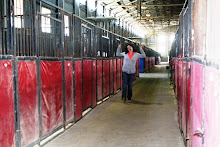First we monitored what was already in place; A 500 gallon tank holds water for the pond cabin, feeding a gravity based plumbing system. Translation – the tank sits uphill from the cabin; instead of putting in pumps, the water just naturally flows downhill into the holding tank and then into the actual plumbing. Doesn’t make for greatest water pressure, but is a very simple system that works.
For this loft cabin with a composting toilet, the 500 gallon tank isn’t quite enough during our driest months (August, September, October) so we knew that we’d need bigger tanks for the second cabin where we would be living primarily.
And bigger we got…
Two 1750 gallon water tanks that we needed to be bury an estimated 5 feet below ground to avoid freezing.
We put these tanks directly behind the road cabin, again utilizing gravity to increase the amount of water pressure and reduce the demand on a water pump. You’ll notice in the images we are using a backhoe to put this specific tank in place – very helpful when lifting 700+pounds but we dug out the holes by hand and placed the first tank by hand with the help of a few close friends – THANK YOU! (I missed the photo-ops for those as I was at work but I hear it was pretty tricky.)
Once we had the tanks in their rightful places, we began burying. We connected the tanks with an easy siphoning system so as one tanks water level decreases, it automatically siphons water from the other. This keeps the primary tank full and allows the secondary tank to collect the rain water off of our roof.
We’ve set-up a gutter on one side of our roof that gathers all of our rain water, immediately feeding it into the secondary tank where it is stored.
While experimenting with our tanks, we also tapped a spring located directly behind the house that now fills a well; we dug a 10 foot deep hole, filling the bottom 3 feet with gravel of varying sizes. The well level varies depending on the season and the weather but this allows us to fill the secondary tank easily, again siphoning the water from the well into the tank.
Now with these two tanks in place, we alleviated some of our concerns and were able to bathe freely! Showers are glorious! But we still hadn’t combated the garden.
While the creek is running, we simply tap the creek and water the garden out of a holding pond that collects to overflow from our tanks and our micro-hydro system but with the creek dry…we’ve begun to realize how quickly plants dry out. A rain storm came through a couple of days ago and renewed our hope in the garden but again, we are reduced to hand watering the healthier of the plants. Not ideal but while we keeping exploring ideas, it seems to be our best option.
Any suggestions out there? We’ve thought about just randomly placing rainwater tanks around the yard and using those as we can, I’ve actually vicariously placed a few large containers throughout the garden when rain is in the forecast, just in case, but still not sure what our best option is…
Check back to find out the difference between indoor shower vs. outdoor shower (another way we save water) and a composting toilet vs. a dual flush, energy star toilet. What’s easier? What’s the most effective? What’s the smelliest?
Peace,
B’Bellie











1 comment:
can't you put in a 'gutter' at the end of the garden to collect run off and then return to top using little pump!
Post a Comment